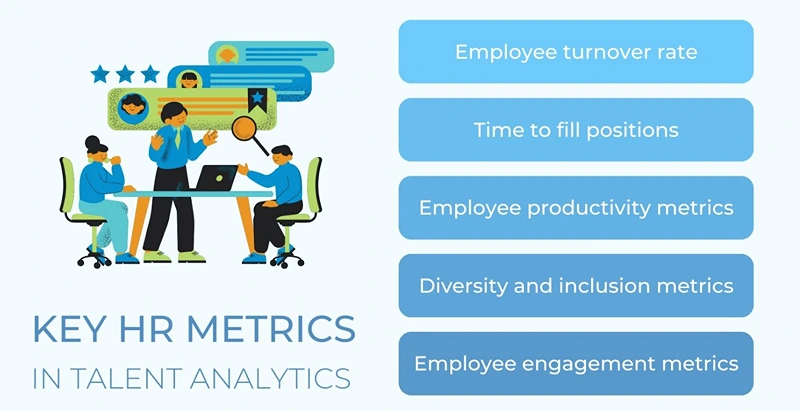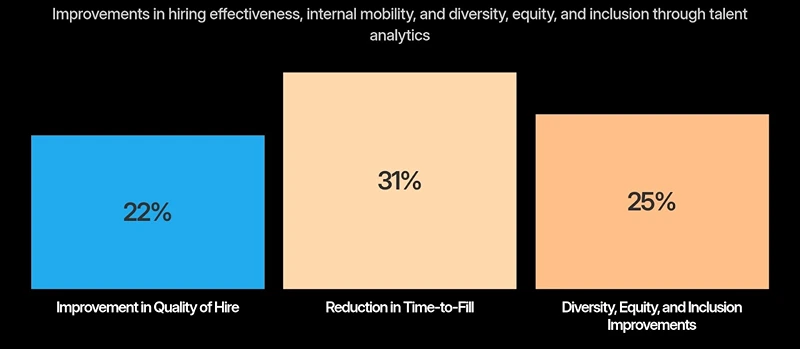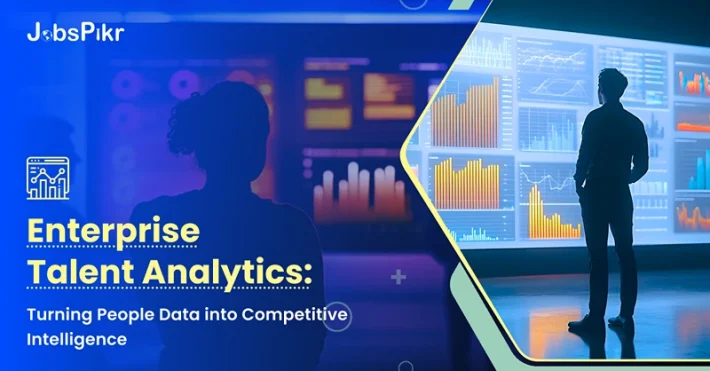Talent is among the greatest assets that businesses possess, and its agility adds to the current business climate. As organizations attempt to adapt to the new competitive reality of being efficient and future orientated, one truth cannot be contested anymore: decisions around people cannot be made on gut feelings. This is where talent analytics comes in, offering HR and business leaders new perspectives toward their workforce using data, insights, and foresight for decision-making.
With talent analytics, people data becomes a source of competitive advantage. It goes beyond forecasting to ensure all routine HR metrics can anticipate value, skill gaps, recruitment optimization, and succession planning. For Workforce Intelligence Teams and CHROs, this transformation isn’t solely about operational efficiency; it’s enabling smarter decisions that affect profitability, innovation, and sustained growth.
In the 2024 Global Human Capital Trends report by Deloitte, 78% of organizations believe leveraging workforce data for decision-making would be a competitive advantage, while only 22% claim to be good at it. This gap, where talent analytics comes in, provides significant value.
What is Talent Analytics?
Talent analytics is the assessment and overview of employees that incorporates data analysis techniques. Such data includes hiring rates, employee engagement levels, company contribution to learning, and even their performance reviews. The objective is far beyond reporting, diving deep into predicting the organization’s future and making recommendations on what actions should be taken.
Modern-day talent analytics focuses on more than just basing insights on past data. It includes data-driven insights, foresight, benchmarking, and goal-oriented planning. Take the marketing department’s high turnover rate during the most recent quarter as an example; outdated approaches would only document the occurrence, whereas analytics would examine the reasons behind it and assess the possibility of the situation repeating elsewhere, helping inform decisions regarding retention interventions.
Talent analytics also extends into areas like:
- Workforce segmentation: Understanding different employee groups and their impact.
- Succession planning: Identifying high-potential individuals and future leaders.
- Talent pipeline health: Forecasting how long it will take to fill critical roles.
It’s this combination of breadth and depth that makes talent analytics a must-have capability for enterprise HR teams.

The Importance of Talent Data Analytics
Data analytics has reshaped every business function—from finance to marketing—and HR is no exception. When applied correctly, talent data analytics helps enterprises:
Track and Improve Hiring Effectiveness
Talent data can uncover how long it takes to fill roles, which channels deliver the best candidates, and what qualities predict long-term success. Instead of anecdotal hiring decisions, analytics brings clarity and objectivity.
Monitor Internal Mobility Trends
Internal mobility is increasingly linked to retention and engagement. Talent analytics can show who is moving where, how internal candidates perform compared to external hires, and where hidden talent exists.
Identify Skills Gaps and Training Needs
By comparing the current workforce’s skill inventory against future strategic goals, organizations can identify where to invest in learning and development. This makes upskilling and reskilling more targeted and cost-effective.
Support Diversity, Equity, and Inclusion (DEI)
Analytics can highlight disparities in hiring, promotions, or compensation, enabling leaders to take meaningful steps toward equity. For example, analyzing promotion rates by demographic group can help uncover systemic bias.
The impact of talent analytics is not hypothetical. A 2023 LinkedIn report found that organizations using analytics in their talent strategy saw a 22% improvement in quality of hire and a 31% reduction in time-to-fill.

Leveraging Talent Market Analysis Tools
While internal data is vital, it tells only part of the story. Talent market analysis tools complement internal insights with external context—providing a 360-degree view of workforce dynamics.
These tools gather data from millions of job postings, labor market databases, and salary surveys to give enterprises real-time visibility into:
- Market demand for specific roles and skills
- Emerging job titles and functions
- Hiring activity of key competitors
- Regional supply-demand dynamics
Imagine knowing that demand for AI engineers in Chicago is growing 35% faster than the national average. Or that a competitor has increased hiring for sustainability roles by 50% over the last quarter. This level of detail allows enterprises to shape smarter hiring strategies, refine compensation benchmarks, and anticipate workforce shifts before they become disruptive.
For HR leaders, these insights help answer questions like:
- Should we open a new engineering hub in Austin or Atlanta?
- Is our compensation for data scientists aligned with market benchmarks?
- Where are our competitors focusing their recruitment efforts?
The Role of JobsPikr in Talent Analytics
JobsPikr is designed to help organizations gain deep visibility into both internal and external talent trends through the power of data. As a Talent Market Analysis Tool, JobsPikr provides:
Real-Time Job Market Intelligence
With access to global job postings updated daily, JobsPikr tracks the pulse of the labor market across roles, industries, and regions. Whether you’re planning for expansion or refining your sourcing strategy, our platform offers timely insights to guide your decisions.
Skill and Demand Heatmaps
JobsPikr visualizes where specific skills are most in-demand, how that demand is changing, and what job titles are associated with those skills. This is invaluable for workforce planners building future-focused hiring and learning strategies.
Competitor Benchmarking
See what roles your peers and competitors are hiring for, what locations they are targeting, and how their job descriptions and benefits compare. This helps you differentiate your employer brand and stay ahead in competitive markets.
Seamless Integration
JobsPikr integrates with existing HRIS and ATS platforms, enabling HR teams to combine internal data with external labor market intelligence for a unified view.
For CHROs, JobsPikr offers not just data, but decision-making power.
Implementing a Data-Driven Talent Strategy
Adopting talent analytics isn’t just about using new tools—it requires a shift in culture and process. Here’s how to make it successful:
Step 1: Build the Right Foundations
Ensure your people’s da ta is clean, accessible, and integrated across systems. Invest in infrastructure that supports data collection and analysis.
Step 2: Start with High-Impact Use Cases
Don’t try to analyze everything at once. Begin with business-critical questions—like improving retention in tech roles or identifying leadership pipeline gaps—and build momentum with early wins.
Step 3: Upskill Your HR Teams
Train HR professionals to think analytically, ask the right questions, and interpret data with a business mindset. Data literacy is a foundational skill for modern HR teams.
Step 4: Embed Analytics into Decision-Making
Make talent data a routine part of business planning. Include it in workforce strategy sessions, board presentations, and budget planning.
Step 5: Track Outcomes and Continuously Improve
Set clear KPIs for your analytics efforts—like reducing time-to-fill or increasing internal promotions—and track progress. Use feedback loops to refine your models and approaches.
According to Gartner, organizations that embed analytics into workforce planning are 1.6x more likely to exceed business outcomes than those that don’t.
From People Data to Strategic Intelligence
Talent analytics gives enterprises the visibility, foresight, and agility to make workforce decisions with confidence. In a world where talent is a primary driver of business success, turning people’s data into competitive intelligence isn’t just a nice-to-have—it’s a necessity.
With the right tools and mindset, CHROs and Workforce Intelligence Teams can lead the charge. Platforms like JobsPikr make it easier than ever to access, analyze, and act on the insights hidden in both your internal data and the broader market.
The future of talent strategy is data-driven. And the future starts now. If you’re ready to harness real-time workforce intelligence, sign up on JobsPikr and see how better insights can fuel smarter talent decisions. The visibility, foresight, and agility to make workforce decisions with confidence. In a world where talent is a primary driver of business success, turning people’s data into competitive intelligence isn’t just a nice-to-have—it’s a necessity.
With the right tools and mindset, CHROs and Workforce Intelligence Teams can lead the charge. Platforms like JobsPikr make it easier than ever to access, analyze, and act on the insights hidden in both your internal data and the broader market.
The future of talent strategy is data-driven. And the future starts now.



